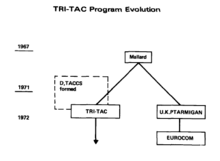User:KD5TVI/test
Joint Tactical Communication (TRI-TAC) Program
[edit]
Between 1967 and 1969, the United States, along with the United Kingdom, Canada, and Australia, sought to develop an interoperable communication system. The effort was known as Project MALLARD. The system design was agreed upon by all parties in 1969. Shortly thereafter, the United States pulled out of the project.[1]: 6
The Senate Armed Service Committee had recommended that a system be developed "without the complications of active international participation". In February 1971, the Joint Tactical Communications (TRI-TAC) Program was approved with the goal of:[1]: 8
- Interoperability
- Communications commonality
- Centralized management of telecommunications
- Cost
Switching and Control (Rewrite)
[edit]The AN/TTC-39 circuit switch was the prime piece of equipment used for TRI-TAC switching and control.[2] The AN/TTC-39 was built by GTE-Sylvania in a 300-line and a 600-line configuration. A companion switch, the AN/TYC-13 (GTE-Sylvania), was also utilized and was built with a 25 or 50-line configuration.[1]: 30 [3]: 6–13
The United States Marine Corps utilized the AN/TTC-42 switch, built by ITT,[1]: 45 which came in a 75 or 150-line configuration.[1]: 32
The smallest switching device was the SB-3865 Unit Level Automatic Switchboard, capable of handling 30 lines but stackable to 60 or 90 lines and interoperable with the TTC-42.[1]: 32 [4]
Transmission
[edit]Connectivity to other switching nodes was accomplished utilizing multichannel UHF and SHF radios.
- AN/TRC-170 - Tropospheric scatter terminal with a maximum range of 200 miles. Developed by Raytheon.[3]: 6–50
- AN/TRC-175 - UHF line-of-sight Multichannel Terminal[5]: 3-58 [3]: 6-59–6-61
References
[edit]- ^ a b c d e f de Dufour, William F. (1 November 1977). Description of TRI-TAC Equipment Acquisition Program (PDF) (Report). McLean, Virginia: METREK Division of The MITRE Corporation. F19626-78-C-0001. Archived (PDF) from the original on 25 August 2022. Retrieved 25 August 2022 – via Defense Technical Information Center.
- ^ Pike, John; Sherman, Robert (9 January 1999). "AN/TTC-39 TRI-TAC Automatic Telephone Central Office". Federation of American Scientists. Archived from the original on 2 July 2022. Retrieved 26 August 2022.
{{cite web}}:|archive-date=/|archive-url=timestamp mismatch; 2 June 2022 suggested (help) - ^ a b c Field Manual 24-24: Signal Data References: Signal Equipment (PDF) (Report). Department of the Army. 29 December 1994. Archived (PDF) from the original on 27 August 2022. Retrieved 27 August 2022 – via Berlin Information-center for Transatlantic Security.
- ^ Pike, John; Sherman, Robert (5 January 1999). "SB-3865 TRI-TAC Switchboard". Federation of American Scientists. Archived from the original on 17 July 2022. Retrieved 26 August 2022.
{{cite web}}:|archive-date=/|archive-url=timestamp mismatch; 16 July 2022 suggested (help) - ^ Field Manual 11-43: The Signal Leader's Guide (PDF) (Report). Department of the Army. 12 June 1995. Archived (PDF) from the original on 26 August 2022. Retrieved 27 August 2022 – via Berlin Information-center for Transatlantic Security.
{{cite report}}:|archive-date=/|archive-url=timestamp mismatch; 14 February 2019 suggested (help)
TRI-TAC citations
[edit]- de Dufour, William F. (1 November 1977). Description of TRI-TAC Equipment Acquisition Program (PDF) (Report). McLean, Virginia: METREK Division of The MITRE Corporation. F19626-78-C-0001. Archived (PDF) from the original on 25 August 2022. Retrieved 25 August 2022 – via Defense Technical Information Center.
- Ulfers, Horst (1 February 1980). AN/TTC-39 Switch Simulator User's Guide (PDF) (Report). Reston, Virginia: Defense Communications Engineering Center. Technical Note 3-80. Archived (PDF) from the original on 26 August 2022. Retrieved 26 August 2022 – via Defense Technical Information Center.
- O'Connor, F. E.; Fairall, R. L.; Birdseye, E. H. (1 January 1984). AN/TTC-39 Program: A Case Study of Manpower, Personnel and Training Requirements Determination (PDF) (Report). Arlington, Virginia: U.S. Army Research Institute for the Behavioal and Social Sciences. Research Note 84-31. Archived (PDF) from the original on 26 August 2022. Retrieved 26 August 2022 – via Defense Technical Information Center.
- Field Manual 24-24: Signal Data References: Signal Equipment (PDF) (Report). Department of the Army. 29 December 1994. Archived (PDF) from the original on 27 August 2022. Retrieved 27 August 2022 – via Berlin Information-center for Transatlantic Security.
- Field Manual 11-43: The Signal Leader's Guide (PDF) (Report). Department of the Army. 12 June 1995. Archived (PDF) from the original on 26 August 2022. Retrieved 27 August 2022 – via Berlin Information-center for Transatlantic Security.
{{cite report}}:|archive-date=/|archive-url=timestamp mismatch; 14 February 2019 suggested (help) - Pike, John; Sherman, Robert (5 January 1999). "SB-3865 TRI-TAC Switchboard". Federation of American Scientists. Archived from the original on 17 July 2022. Retrieved 26 August 2022.
{{cite web}}:|archive-date=/|archive-url=timestamp mismatch; 16 July 2022 suggested (help) - Pike, John; Sherman, Robert (9 January 1999). "AN/TTC-39 TRI-TAC Automatic Telephone Central Office". Federation of American Scientists. Archived from the original on 2 July 2022. Retrieved 26 August 2022.
{{cite web}}:|archive-date=/|archive-url=timestamp mismatch; 2 June 2022 suggested (help)
